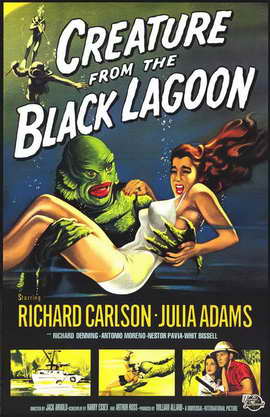Clawing monster from a lost age strikes the Amazon’s forbidden depths!
Be a farmer or not, 1954 is a bumper crop—for horror movies. Imagine, in a single year, the many delicious, delectable, diabolical—and sometimes dumb—exploits added to the distorted world of this particular genre.
Let’s see . . . among the “lower,” properly forgettable films of that year: Killers from Space, Monster from the Ocean Floor, Gog and Godzilla. Deeper, deeper, at the murkiest bottom, the lower regions of nothingness: The Bowery Boys Meet the Monsters, Devil Girl from Mars, Monsters from the Rue Rogue and The Snow Creature. But working quality upward, there’s light, and despite those who see a disreputable genre, some titles rise above that notoriety and become something more: The Mad Magician, Them! and The Naked Jungle.
And, in this year of 1954, what about The Creature from the Black Lagoon? Where does it stand in this bubbling cauldron of hell-broth? Some critics go so far as to endow the film with high praise indeed, that its creature, a resilient fish-man or gill-man—all monsters are “resilient,” just look at the armies which try to defeat them—belongs in the illustrious company of Dracula, the Frankenstein monster, the Wolf Man and the Mummy.
Truly, Creature, along with its monster, is one of the most original horrors of the 1950s.
Whatever its status among the horror hierarchy, the idea for Creature comes from the fertile—or festered?—mind of William Alland. If the name is unfamiliar, it shouldn’t be: he’s Mr. Thompson the reporter, usually seen in silhouette, who is in search of the meaning of “Rosebud,” the dying word of the egotistical newspaper tycoon in Orson Welles’ famous 1940 movie Citizen Kane.
Much more than a minor actor, Alland is better known as a producer of horror films—It Came from Outer Space (1953), This Island Earth (1955), Tarantula (1955), The Deadly Mantis (1957) and, of course, the creature feature under discussion.
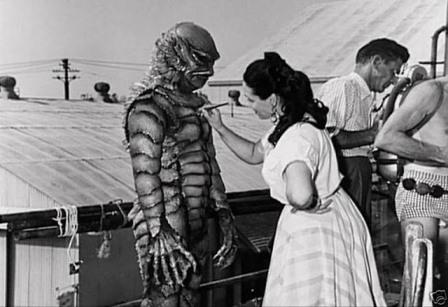 Alland, a member of Welles’ Mercury Theatre on the Air, with a hand in the 1938 radio scare of a Martian invasion, War of the Worlds, attended one particular dinner party given by Welles. Alland heard Mexican cinematographer Gabriel Figueroa (later an Oscar nominee for John Huston’s The Night of the Iguana, 1964) regale his audience with the legend of a half-fish, half-man creature that terrorized the Amazon River, emerging annually to possess a woman victim.
Alland, a member of Welles’ Mercury Theatre on the Air, with a hand in the 1938 radio scare of a Martian invasion, War of the Worlds, attended one particular dinner party given by Welles. Alland heard Mexican cinematographer Gabriel Figueroa (later an Oscar nominee for John Huston’s The Night of the Iguana, 1964) regale his audience with the legend of a half-fish, half-man creature that terrorized the Amazon River, emerging annually to possess a woman victim.
Alland had the idea, Maurice Zimm put it on paper and screenwriters Harry Essex and Arthur Ross converted it to screen. And Jack Arnold, no stranger to directing other “creature” films, including his masterpiece The Incredible Shrinking Man (1957), directs Creature.
Composers Hans J. Salter, Henry Mancini and Herman Stein, along with some Universal stock footage—even a snip from 1941’s The Wolf Man—assemble an unexpectedly integrated score. Beware, however, of that three-note “creature theme” on the flutter-tongue trumpets. Even if it’s only a claw, the motif blares out each time the creature appears and so often the motif quickly becomes a boring nuisance long after any terror-striking effect has worn off. Still, the three notes could be the most memorable of its kind since Franz Waxman’s five-note “monster theme” in The Bride of Frankenstein (1935).
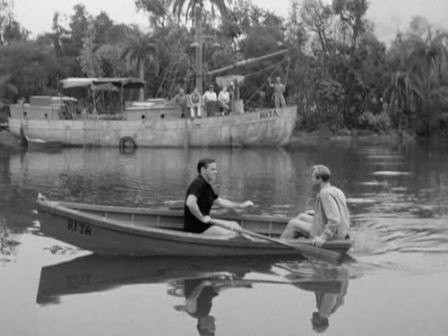
Aside from some scenes shot in a water tank, most of the underwater photography was filmed by a second unit, over 2,000 miles from Hollywood, in the sparkling clear waters of Wakulla Springs, about fourteen miles south of Tallahassee, Florida. One of the first films shot there was Tarzan’s New York Adventure (1938).
So it is to this spring, passing for the Upper Amazon, that a scientist, Dr. Carl Maia (Antonio Moreno, Captain from Castile, 1947, The Searchers, 1956), finds the fossilized remains of a scaly forearm and webbed claw-hand.
Not even three minutes into the film, the audience hears the three-note motif, fortissimo, and is teased, some might think prematurely, by, this time, a living claw-hand groping at the river bank. Carl has his back turned to this, of course.
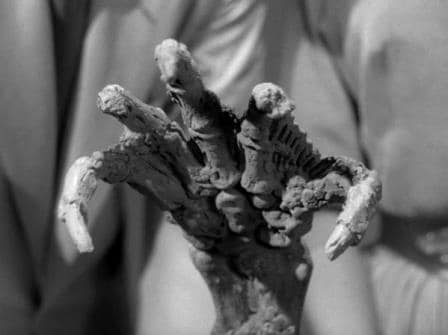 Carl returns to civilization and recruits three companions for an expedition—ichthyologist Dr. David Reed (Richard Carlson, It Came from Outer Space, etc.), the financial backer of this expedition, Mark Williams (Richard Denning, the governor in TV’s Hawaii Five-O, 1968-80), and David’s girlfriend, Kay (Julie Adams, The Private War of Major Benson, 1955), the requisite “female in danger”—the woman the creature is after in any horror film.
Carl returns to civilization and recruits three companions for an expedition—ichthyologist Dr. David Reed (Richard Carlson, It Came from Outer Space, etc.), the financial backer of this expedition, Mark Williams (Richard Denning, the governor in TV’s Hawaii Five-O, 1968-80), and David’s girlfriend, Kay (Julie Adams, The Private War of Major Benson, 1955), the requisite “female in danger”—the woman the creature is after in any horror film.
With tag-along scientist Dr. Thompson (Whit Bissell, Hud, 1963, Seven Days in May, 1964) aboard, they arrive by river trawler at Carl’s camp, only to find two of his aids dead. The jovial captain of the “Rita” is Lucas (Nestor Paiva, Humoresque, 1946, Tarantula).
After finding no more fossils, David believes that any possible remains might have been washed down the river thousands of years ago, and in traveling further down the waterway they discover the black lagoon with its primeval forest rising from water’s edge.
Having noticed Kay, the creature has followed the trawler to the lagoon, establishing the beauty-and-the-beast premise, specifically King Kong (1933), the writers admitted source of their story. After David and Mark have dived for rocks in the lagoon, Kay goes swimming and the fish-man, somehow unnoticed, swims along beneath and around her.
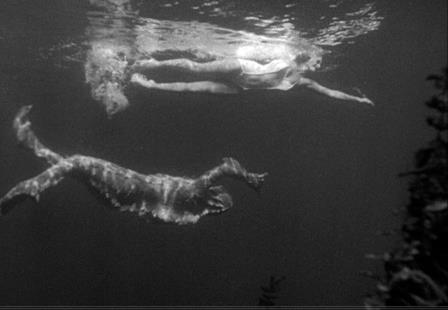 The creature later climbs aboard the “Rita” and kills some of Lucas’ crew before its capture and confinement in a bamboo cage. When the scaly prisoner escapes, he mauls Thompson. Kay tosses a lantern and, in flames, the creature jumps overboard.
The creature later climbs aboard the “Rita” and kills some of Lucas’ crew before its capture and confinement in a bamboo cage. When the scaly prisoner escapes, he mauls Thompson. Kay tosses a lantern and, in flames, the creature jumps overboard.
David wants to end the expedition, but Mark is bent on capturing, or killing, the fish-man. There are more struggles. The “Rita” is locked in the lagoon by some loose logs moved by the creature and Mark is killed in an underwater fight with the aquatic adversary.
When Kay is kidnapped to a grotto by the fish-man, David, Carl and Lucas rescue her, but not before shooting the creature, which retreats into the lagoon. The last shot of the film is of its body sinking limply to the bottom of the lagoon.
The Creature from the Black Lagoon, which seems, at least on first viewing, so unified creatively, contains at least six “doubles,” necessitated by the second unit work in distant Florida. The credited “surface” director might be Jack Arnold, but for the underwater scenes it is James C. Havens. Likewise, the Hollywood cinematographer, William E. Snyder, is replaced in Florida by Scotty Westbourne, using a then innovative underwater camera. This was about the same time as Beneath the 12-Mile Reef (1953) and 20,000 Leagues under the Sea (1954), films known, at the time, for their spectacular underwater photography.
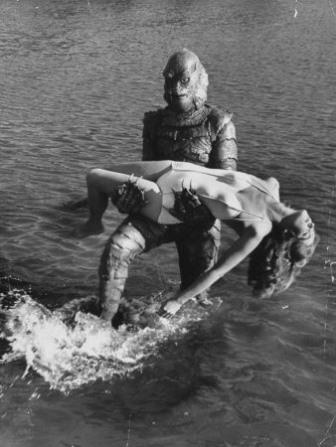 In Hollywood, lead actress Julie Adams is making her signature movie, while beneath the water, exhibiting acrobatic stunts and somersaults, is Ginger Stanley, then a performer at Florida’s Silver Springs tourist attraction. In the swimming sequence between “Adams” (Stanley) and the fish-man, some critics have seen a highly erotic ballet, a “love dance,” intimations of sexual intercourse, albeit from a distance.
In Hollywood, lead actress Julie Adams is making her signature movie, while beneath the water, exhibiting acrobatic stunts and somersaults, is Ginger Stanley, then a performer at Florida’s Silver Springs tourist attraction. In the swimming sequence between “Adams” (Stanley) and the fish-man, some critics have seen a highly erotic ballet, a “love dance,” intimations of sexual intercourse, albeit from a distance.
Aside from the water tank shots, actors Carlson and Denning are doubled in the lagoon sequences by two local college students hired for the occasion. On the boat and getting in and out of the water, Carlson wears two air tanks, Denning only one, a distinction replicated by the stand-ins beneath the surface.
Even the fish-man leads two lives. Stalking on the surface, climbing aboard the trawler, being set on fire or shot at, Ben Chapman is the creature; under the water it’s Ricou Browning, who, as a result of this filming experience, became a director, writer, producer and underwater cinematographer.
Milicent Patrick, supposedly the first woman animator at the Walt Disney Studios, designed the creature’s outfit, though Bud Westmore took unfair credit, as is so often the case with him.
With the fish-man only presumably dead in the end, the writers and producer left room for—that’s right!—a sequel, and not one but two. Neither The Revenge of the Creature (1954) nor The Creature Walks Among Us (1956) is as good as the original, and although still another remake is rumored, so far the nearest to one is The Shape of Water (2017), which its director, Guillermo del Toro, said was inspired by the 1954 film.
[embedyt] https://www.youtube.com/watch?v=lM1o1xe5FGE[/embedyt]
